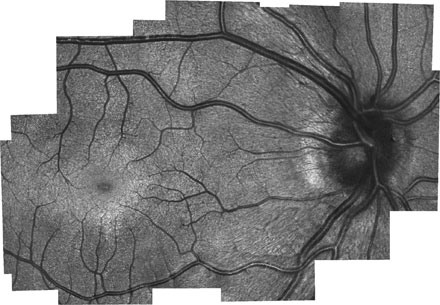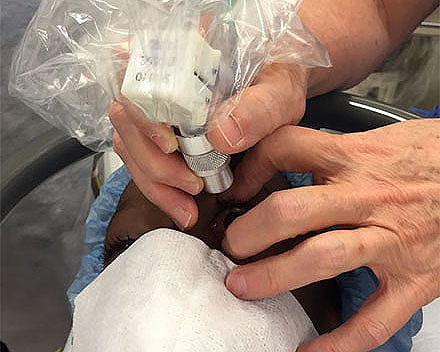A handheld device capable of capturing images of a retina with cellular resolution allows researchers to gather detailed structural information about the eyes of infants and toddlers for the first time.
"Diagnostic tools that examine and image the retina have been
well-designed for adults, but are exceedingly difficult to use in
infants and young children who can't hold the required position or focus
for long enough periods of time," said Cynthia Toth, professor of
ophthalmology and biomedical engineering at Duke University. "Before
now, it hasn't been possible to measure the impact of injury or diseases
on their photoreceptors, the cells in the eye in which light is first
converted into nerve signals."

An image of a retina taken with the handheld probe. The tiny white dots are photoreceptors called cones, which were not visible with previous handheld technologies. The concentrated circular area is called the fovea. It is believed that, as the eye matures, photoreceptors migrate to this area, making it much more densely populated than others. Courtesy of Joseph Izatt/Duke University.
Over the past three decades, one of the most popular technologies for studying structures in the delicate human eye has been optical coherence tomography (OCT), which enables 3D images several millimeters deep of the back of the eye.
OCT equipment is bulky, and a patient must sit still in front of the machine and remain focused on a particular point. The process takes tens of minutes, which is an eternity to most toddlers, the researchers note. Existing handheld devices based on OCT and other technologies can weigh several pounds, and none provide a sufficient resolution to see individual photoreceptors.
Now the team of researchers and ophthalmologists from Duke have demonstrated a handheld device weighing 94 g and capable of gathering detailed information about the retina's cellular structure. It uses a scanning mirror that replaces older optics. The design uses converging rather than collimated light, which cut the telescoping length of the device by a third. Custom lenses detailing curvature, thickness and glass type were designed by researcher Francesco LaRocca and specially fabricated. A mechanical system to hold and integrate the components was designed by researcher Derek Nankivil. The device was fabricated in a machine shop on Duke's campus.
The device was tested by clinicians on adults to prove it capable of capturing accurate photoreceptor density information. It was also used for research imaging in children who were already having an eye exam under anesthesia.

A clinician uses the handheld device. Previous technologies weighed several pounds and lacked sufficient resolution for effective diagnosis and observation in children. Courtesy of Joseph Izatt/Duke University.
"But because children have never been imaged with these systems before, there's no gold standard that we can compare it to," said LaRocca. "The results do, however, match theories of how cones migrate as the eye matures. The tests also showed different microscopic pathological structures that are not normally possible to see with current lower-resolution clinical-grade handheld systems."
The group is already working on the next generation of the design after getting feedback from clinicians on what can be improved.
The research was published in Nature Photonics (doi: 10.1038/nphoton.2016.141).